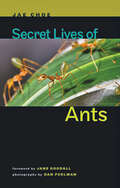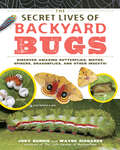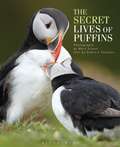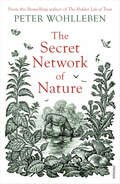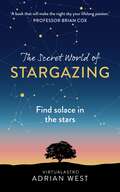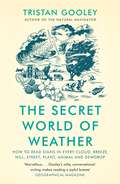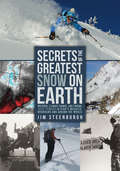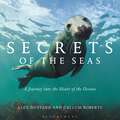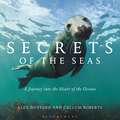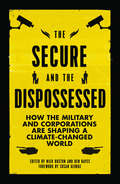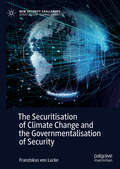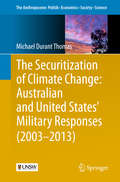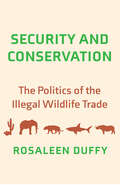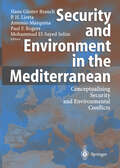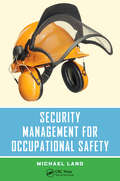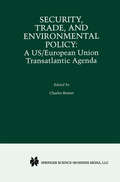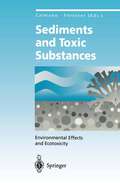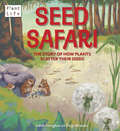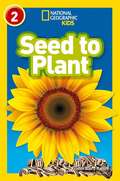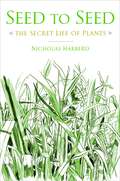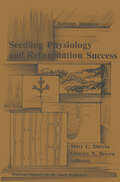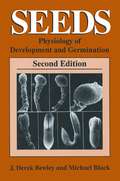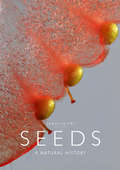- Table View
- List View
Secret Lives of Ants
by Jae ChoeIn the great naturalist tradition of E. O. Wilson, Jae Choe takes readers into a miniature world dominated by six-legged organisms. This is the world of the ant, an insect that humans, as well as most other life forms, depend upon for their very survival. Easily one of the most important animals on earth, ants seem to mirror the actions, emotions, and industries of the human population, often more effectively than humans do themselves. They developed ranching and farming long before humans, and their division of labor resembles the assembly lines of automobile factories and multinational enterprises. Self-sacrifice and a finely tuned chemical language are the foundations of their monarchical society, which is capable of waging large-scale warfare and taking slaves. Tales of their massacres and atrocities, as well as struggles for power, are all too reminiscent of our own. The reality of ant society is more fascinating than even the most creative minds could imagine. Choe combines expert scientific knowledge with a real passion for these miniscule marvels. His vivid descriptions are paired with captivating illustrations and photographs to introduce readers to the economics, culture, and intrigue of the ant world. All of nature is revealed through the secret lives of the amazing ants. In the words of the author, "Once you get to know them, you’ll love them."
The Secret Lives of Backyard Bugs: Discover Amazing Butterflies, Moths, Spiders, Dragonflies, and Other Insects!
by Judy Burris Wayne RichardsThis fun book will have kids bugging out! Explore the fascinating miniature world of spiders, beetles, grasshoppers, butterflies, and more as stunning photography combines with expert information to create an up-close-and-personal look at the hidden lives of these tiny backyard residents. Watch each creature progress through different life stages as they eat, grow, and learn in a natural setting. Surprising and captivating, this one-of-a-kind introduction to the crawlers and flyers just outside the door is a delight for nature lovers of all ages.
The Secret Lives of Puffins
by Mr Dominic Couzens Mark SissonPuffins are among the most instantly recognisable, iconic and well loved of birds. For many they are a highlight of the UK's summer coastline and their colourful appearance, comedy antics and approachability just add to their popularity. Several 'hotspot' are attracting high levels of interest in visits to their colonies. In spite of the high level of interest in, and appeal of, these birds there has been a surprising lack of books focused on Puffins as a species.Award-winning wildlife photographer Mark Sisson has spent several years photographing Puffins and this new book combines images that beautifully encapsulate their charm and visual appeal with an accessible text written by leading wildlife writer Dominic Couzens. The book covers the birds' life cycle, behaviour, habitats and the current and future challenges that they face, along with many surprising facts and anecdotes.
The Secret Network of Nature: The Delicate Balance of All Living Things
by Peter Wohlleben'Peter Wohlleben doesn't merely look, he sees. Let's all learn as much from him as we can, and quickly.' Rosamund Young, author of THE SECRET LIFE OF COWSDid you know that trees can influence the rotation of the earth?Or that wolves can alter the course of a river?Or that earthworms control wild boar populations?The natural world is a web of intricate connections, many of which go unnoticed by humans. But it is these connections that maintain nature’s finely balanced equilibrium.Drawing on the latest scientific discoveries and decades of experience as a forester and bestselling author, Peter Wohlleben shows us how different animals, plants, rivers, rocks and weather systems cooperate, and what's at stake when these delicate systems are unbalanced.The earth's ecosystems are too complex for us to compartmentalise and draw up simple rules of cause and effect; but The Secret Network of Nature gives us a chance to marvel at the inner workings and unlikely partnerships of the natural world, where every entity has its own distinct purpose.And the more light that is shed on relationships between species, the more fascinating nature's web becomes.
The Secret World of Stargazing: Find solace in the stars
by Adrian West'A book that will make the night sky your lifelong passion. An invitation to immerse yourself in the nature around you and the universe beyond.' - Professor Brian CoxThe Secret World of Stargazing is the ultimate guide to set you on your epic journey around the cosmos - it's a simple guide to the skies and makes stargazing fun, easy and enjoyable for all - absolutely no equipment is required! Adrian West, AKA the internet sensation VirtualAstro, will take you through the seasons, showing you exactly what you can spot in the sky throughout the year, whether you're in your back garden or sitting on an exotic beach somewhere! While you're learning how to spot constellations, meteors and comets, you will be switching off your busy mind, sitting still in nature and paying attention to the small details that make up the big picture of life. You'll finish reading this beautiful book and come away with a sense of grounding, connection, knowledge and a whole new appreciation of the sky above and the world outside your own - it will soothe your soul.'Stargazing is a lovely book. It's personal, delicate and beautifully innocent. For those more experienced astronomers, it is a reminder of why so many of us immerse ourselves in the hobby, and for those just starting out, it is a useful leg-up onto the first rung of the stargazing ladder.' - Katrin Raynor-Evans, Fellow of the Royal Astronomical Society and an astronomy writer, BBC Sky at Night
The Secret World of Weather: How to Read Signs in Every Cloud, Breeze, Hill, Street, Plant, Animal, and Dewdrop
by Tristan Gooley'After 40 years as a professional meteorologist, I've looked at the weather through Tristan Gooley's fresh eyes and seen new things.' -- Peter Gibbs, Weatherman and BBC Presenter***The weather changes as we walk around a tree or turn down a street. There is a secret world of weather - one that we all live in, but very few see. Each day we pass dozens of small weather signs that reveal what the weather is doing all around us - and what is about to happen. The clues are easy to spot when you know how, but remain invisible to most people. In The Secret World of Weather you'll discover the simple rules that explain the weather signs. And you'll learn rare skills that enhance every minute you spend outdoors, whether you are in a town, on a beach or in a wilder spot. As the author of the international bestsellers THE WALKER'S GUIDE and HOW TO READ WATER, Tristan Gooley knows how to de-code the phenomena and signs to look for. As he says, 'I want you to get to know these signs as I have, as characters. By studying their habits and behaviours, the signs come to life and the meaning reveals itself. From this flows an ability to read what is happening and what is about to happen'.This is the ultimate guide to exploring an undiscovered world, one that hides in front of our eyes.
Secrets of the Greatest Snow on Earth: Weather, Climate Change, and Finding Deep Powder in Utah's Wasatch Mountains and around the World
by Jim SteenburghUtah has long claimed to have the greatest snow on Earth—the state itself has even trademarked the phrase. In Secrets of the Greatest Snow on Earth, Jim Steenburgh investigates Wasatch weather, exposing the myths, explaining the reality, and revealing how and why Utah’s powder lives up to its reputation. Steenburgh also examines ski and snowboard regions beyond Utah, making this book a meteorological guide to mountain weather and snow climates around the world. Chapters explore mountain weather, avalanches and snow safety, historical accounts of weather events and snow conditions, and the basics of climate and weather forecasting. Steenburgh explains what creates the best snow for skiing and snowboarding in accurate and accessible language and illustrates his points with 150 color photographs, making Secrets of the Greatest Snow on Earth a helpful tool for planning vacations and staying safe during mountain adventures. Snowriders, weather enthusiasts, meteorologists, students of snow science, and anyone who dreams of deep powder and bluebird skies will want to get their gloves on Secrets of the Greatest Snow on Earth. Watch Book Trailer!(Special thanks to Ski Utah)
Secrets of the Seas: A Journey into the Heart of the Oceans
by Callum RobertsOur seas are host to an extraordinary variety of plant and animal life, but much of it remains mysterious and great imagery is surprisingly hard to find. Alex Mustard is one of the world's leading underwater photographers and his images are so crisp and immediate that the animals seem to swim out of the water towards you. This beautiful book gathers together a selection of his award-winning images and a number of new ones to create a vivid picture of the seas and oceans and the animals that inhabit them, each chapter accompanied by a 1500 word essay and extended captions written by leading natural history writer, Professor Callum Roberts. The text addresses the issue of change in the oceans along with tales of oceanography, marine life and human history in the seas and aims to help the reader to get to know the oceans, understand how marine animals live their lives and how they have, are and may well adapt to change.
Secrets of the Seas: A Journey into the Heart of the Oceans
by Callum Roberts Alex MustardOur seas are host to an extraordinary variety of plant and animal life, but much of it remains mysterious and great imagery is surprisingly hard to find. Alex Mustard is one of the world's leading underwater photographers and his images are so crisp and immediate that the animals seem to swim out of the water towards you. This beautiful book gathers together a selection of his award-winning images and a number of new ones to create a vivid picture of the seas and oceans and the animals that inhabit them, each chapter accompanied by a 1500 word essay and extended captions written by leading natural history writer, Professor Callum Roberts. The text addresses the issue of change in the oceans along with tales of oceanography, marine life and human history in the seas and aims to help the reader to get to know the oceans, understand how marine animals live their lives and how they have, are and may well adapt to change.
The Secure and the Dispossessed: How the Military and Corporations are Shaping a Climate-Changed World (Transnational Institute)
by Nick Buxton Ben HayesWhile the world's scientists and many of its inhabitants despair at the impact of climate change, corporate and military leaders see nothing but opportunities. For them, melting ice caps mean newly accessible fossil fuels, borders to be secured from 'climate refugees', social conflicts to be managed and more failed states in which to intervene. They are 'securing' their assets at the expanse of the planet and its inhabitants.*BR**BR*The Secure and the Dispossessed looks at these deadly approaches with a critical eye. It also considers the flip-side: that the legitimacy of the elite is under unprecedented pressure – from resistance by communities to resource grabs to those creating new ecological and socially just models for managing our energy, food and water. *BR**BR*Topics covered include geoengineering, militarism, refugee protection, greenwashing and the agricultural crisis among others. Adaptation and resilience to a climate-changed world is desperately needed, but the form it will take will affect all of our futures.
The Secure and the Dispossessed: How the Military and Corporations are Shaping a Climate-Changed World (Transnational Institute)
by Ben Hayes Nick BuxtonWhile the world's scientists and many of its inhabitants despair at the impact of climate change, corporate and military leaders see nothing but opportunities. For them, melting ice caps mean newly accessible fossil fuels, borders to be secured from 'climate refugees', social conflicts to be managed and more failed states in which to intervene. They are 'securing' their assets at the expanse of the planet and its inhabitants.*BR**BR*The Secure and the Dispossessed looks at these deadly approaches with a critical eye. It also considers the flip-side: that the legitimacy of the elite is under unprecedented pressure – from resistance by communities to resource grabs to those creating new ecological and socially just models for managing our energy, food and water. *BR**BR*Topics covered include geoengineering, militarism, refugee protection, greenwashing and the agricultural crisis among others. Adaptation and resilience to a climate-changed world is desperately needed, but the form it will take will affect all of our futures.
The Securitisation of Climate Change and the Governmentalisation of Security (New Security Challenges)
by Franziskus von LuckeThis book provides an in-depth analysis of the securitisation of climate change in the US, Germany and Mexico and offers a rethinking of securitisation theory. Resting on a Foucauldian governmentality approach, it discusses how different climate security discourses have transformed the political handling of climate change and affected policies, practices and institutions. Going beyond the literature’s predominant focus on the global level, it gives a fine-grained examination of the political and institutional changes in different national contexts. Drawing on the governmentalisation of security, the book develops a new understanding of securitisation that focuses on the role of power. In doing so, it provides new insights into the transformative potential of linking climate change to security but also highlights the political and normative pitfalls of securitisation. ‘In this important book, Franziskus von Lucke provides a theoretically sophisticated and empirically rich account of the relationship between security and climate change. Developing a Foucauldian-inspired account of securitization, the book rejects blanket or universal claims about the climate change- security relationship, instead insisting on the need to critically examine how the securitization of climate change plays out in particular empirical contexts. Exploring the cases of the US, Germany and Mexico, von Lucke points to distinctive dynamics of securitization in these settings, with different implications for the practices these in turn encourage. Ultimately, this book constitutes an important addition to literature on the relationship between climate change and security, while developing a distinct and nuanced account of securitization that will be of interest to a wide range of scholars of security in international relations.’—Associate Professor Matt McDonald is a Reader in International Relations at the University of Queensland, Australia ‘In 2019 a number of states and other actors (notably the European Union) have made climate emergency declarations. It is therefore more important than ever to understand what the securitization of the climate means. That is: Who can securitize? What security measures are likely/ deemed legitimate by relevant audiences? How does securitization affect the population within and outside a securitizing state? And perhaps most importantly of all, will it succeed? Franziskus von Lucke’s carefully researched book offers answers to all of these questions and many others besides. von Lucke proceeds by examining with the US, Mexico and Germany, three real-life empirical cases of climate securitization. Each one provides unique insights that enable a fuller understanding of climate security. Accessibly written this is a must read for scholars and practitioners alike.’ —Dr Rita Floyd, University of Birmingham, UK, author of The Morality of Security: A theory of just Securitization, CUP, 2019 With great empirical detail and conceptual clarity, the book compares discourses and practices of climate security in different contexts. An essential reading for anyone interested in international climate politics, securitization theory, governmentality and the notion of power in International Relations. —Dr Delf Rothe, Institute for Peace Research and Security Policy Hamburg at the University of Hamburg, Germany
The Securitization of Climate Change: Australian and United States' Military Responses (The Anthropocene: Politik—Economics—Society—Science #10)
by Michael Durant ThomasThis book examines how the armed forces of the United States and Australia have responded to the threat posed by climate change to national security. Drawing on established securitisation frameworks (‘Copenhagen’ and ‘Paris’ Schools), the author uses a combination of quantitative and qualitative techniques to systematically examine more than 3,500 speeches, policies and doctrinal articles since 2003. Importantly, the author undertakes an examination of the intersection between the political and the military spheres, probing the question of how ideology has influenced the military’s uptake on the issue. In this context, the author identifies the difficulty of an ostensibly apolitical institution responding to what has become both a hyper-political issue and an unprecedented security threat. A close examination of the key political actors – their intent, outlook and political mandate for broader climate action – is therefore crucial to understanding the policy freedom and constraints within which military leaders operate. The book consists of eight chapters divided into four parts, focusing on: perspectives and methodological insights; empirical case studies; case study comparison; and concluding observations.• Offers a rare and systematic examination of military climate policy by a military officer from Australia• Identifies a divergence of Australian military climate policy from that of the US military during the Obama Administration• Develops a unique method that quantifies climate security, enabling a graphical representation for quick and ready reference ideally suited to policy-makers
Security and Conservation: The Politics of the Illegal Wildlife Trade
by Rosaleen DuffyAn exploration of the scale, practical reality, and future implications of the growing integration of biodiversity conservation with global security concerns “There are few keener observers of international biodiversity conservation than Rosaleen Duffy. With a ferocity of purpose, she investigates the tenuous connection and nuances among illegal wildlife trade, terrorism threats, and national security.”—Steven R. Brechin, Rutgers University, New Brunswick Debates regarding environmental security risks have generally focused on climate change and geopolitical water conflicts. Biodiversity conservation, however, is increasingly identified as a critical contributor to national and global security. The illegal wildlife trade is often articulated as a driver of biodiversity losses, and as a source of finance for organized crime networks, armed groups, and even terrorist networks. Conservationists, international organizations, and national governments have raised concerns about “convergence” of wildlife trafficking with other serious offenses, including theft, fraud, corruption, drugs and human trafficking, counterfeiting, firearms smuggling, and money laundering. In Security and Conservation, Rosaleen Duffy examines the scale, practical reality, and future implications of the growing integration of biodiversity conservation with global security concerns. Duffy takes a political ecology approach to develop a deeper understanding of how and why wildlife conservation turned toward security‑oriented approaches to tackle the illegal wildlife trade.
Security and Environment in the Mediterranean: Conceptualising Security and Environmental Conflicts (Hexagon Series on Human and Environmental Security and Peace #1)
by K.S.A Jaber C. Tickell J. Dean E. S. YassinIn this volume security specialists, peace researchers, environmental scholars, demographers as well as climate, desertification, water, food and urbanisation specialists from the Middle East and North Africa, Europe and North America review security and conflict prevention in the Mediterranean. They also analyse NATO’s Mediterranean security dialogue and offer conceptualisations on security and perceptions of security challenges as seen in North and South. The latter half of the book analyses environmental security and conflicts in the Mediterranean and environmental consequences of World War II, the Gulf War, the Balkan wars and the Middle East conflict. It also examines factors of global environmental change: population growth, climate change, desertification, water scarcity, food and urbanisation issues as well as natural disasters. Furthermore, it draws conceptual conclusions for a fourth phase of research on human and environmental security and peace as well as policy conclusions for cooperation and partnership in the Mediterranean in the 21st century.
Security Management for Occupational Safety
by Michael LandHow far would or should you go to feel secure? While everyone wants safety and security, the measures to achieve it are often viewed of as intrusive, unwanted, a hassle, and limiting to personal and professional freedoms. Yet, when an incident occurs, we can never have enough security. Security Management for Occupational Safety provides a framewor
Security, Trade, and Environmental Policy: A US/European Union Transatlantic Agenda
by Charles BonserCenter for European Integration, University of Bonn, Germany Instituto Nacional de Administradio, Lisbon, Portugal Fondazione Eni Enrico Mattei, Milan, Italy University Pompeu Fabra, Barcelona, Spain Danish School of Public Administration, Frederiksberg, Denmark Scuola Superiore della Pubblica Amministrazione, Rome, Italy The papers presented in this volume were originally presented at the Paris and Bloomington conferences. They were subsequently updated, where necessary, to include new information or circumstances. Plans call for future colloquia of the group to publish their results. For current information on the consortium being planned, visit the web page:. Charles F. Bonser Dean Emeritus School of Public and Environmental Affairs Indiana University Bloomington, Indiana U. S. A. SECTION I: INTERNATIONAL SECURITY ISSUES FOR THE EUROPEAN UNION AND THE UNITED STATES INTRODUCTION, SECTION I Charles F. Bonser Dean Emeritus of Public and Environmental Affairs Sclwol Indiana University Bloomington, Indiana It is clear that the collapse of the Soviet Empire at the beginning of this decade has led to what President Bush called, at that time, a "New World Order. " Although no one as yet has defined exactly what that means, it obviously includes the fact that the United States has emerged as the only true super power in the world, at least militarily. If there were any doubts to that fact, the events of the last decade removed them. In the 1991 Gulf War, the U. S.
Sediments and Toxic Substances: Environmental Effects and Ecotoxicity (Environmental Science and Engineering)
by W. Calmano U. FörstnerIn modern sediment research on contaminants five aspects are discussed which, in an overlapping succession, also reflect develop ment of knowledge on particle-associated pollutants during the past twenty-five years: (1) identification of sources and their distribution; (2) evaluation of solid/solution relations; (3) study of transfer mecha nisms to biological systems; (4) assessment of environment impact; and (5) selection and further development of remedial measures, in par ticular, of dredged materials. Scientific research and practical develop ment are still expanding in all these individual aspects. Similar to other waste materials, management of contaminated sed iments requires a holistic approach. This means that assessment of biogeochemical reactions, interfacial processes and transfer mecha nisms as well as the prognosis of long-term borderline conditions, in particular of capacity-controlling properties, should be an integrated part of the wider management scheme, i.e., the analytical and experi mental parameters should always be related to potential remediation options for a specific sediment problem. The underlying coordinated project, which was funded by the German Federal Ministry for Science and Technology (now the Federal Ministry for Education, Science, Research and Technology) provided excellent opportunities for multidisciplinary effort, bringing together biologists, chemists, engineers, geologists and other researchers. During its active phase, the group attracted much interest nationally and internationally. The group members highly appreciate the manifold contacts and invitations during the past five years.
Seed Safari: The Story of How Plants Scatter their Seeds (Plant Life)
by Judith HeneghanLooking at the amazing variety of plants around the world, this title focuses on the ingenious ways in which plants ensure that their seeds are dispersed, whether it's by wind or water or with the help of animals such as insects, birds and mammals.
Seed To Plant: Level 2 (National Geographic Readers Ser.)
by Kristin Baird Rattini National Geographic Kids StaffNational Geographic Primary Readers pair magnificent National Geographic photographs with engaging text by skilled authors to help your child learn to read. Developed by education experts, this series of books for beginner readers is spread across four levels: Early Reader, Becoming Fluent, Becoming Independent and Independent Reader. Children encounter plants, flowers and trees around them every day. In this National Geographic Kids Level 2 Reader, children will follow the magical journey from seed pollination to plant growth, learning fun facts about what plants need in order to thrive and grow. Beautiful photos and carefully levelled text make this book perfect for reading aloud as children become more fluent in their reading. Level 2: Becoming Fluent books are a great match for kids who are developing reading stamina and enjoy a longer book. They are ideal for readers of Green, Orange and Turquoise book bands for guided reading.
Seed to Seed: The Secret Life Of Plants
by Nicholas HarberdNicholas Harberd, a father, scientist, and nature lover, spends his days at the lab directing a team discovering the secrets of how plants grow, using a common weed as their example. Concerned that he's losing sight of the weed's ordinary days in the world, he sets out to find an example of the same plant in the wild. And so begins this unique and beautiful book-part field notebook, part sketchbook, and part journal. Building on a narrative of the passing seasons of 2004, Harberd relates that narrative to the life history of what becomes an iconic plant. As a biologist and close observer, he is able to describe both what is visible and the hidden molecular mechanisms that underlie the visible events in the plant's life. In the process, he reveals what the daily life of a scientist truly is. Beautifully produced, with dozens of diagrams and drawings, and written with thoughtfulness and passion, Seed to Seed is a testament to the wonder of the natural world around us. Nicholas Harberd is one of the world's leading plant biologists. He directs a research team at the John Innes Centre (Europe's premier plant and microbial science research institute) and is Honorary Professor in the Department of Biological Sciences at the University of East Anglia, Norwich. He is the author of numerous scientific papers and has published in the leading international journals Nature and Science.
Seedling physiology and reforestation success: Proceedings of the Physiology Working Group Technical Session (Forestry Sciences #14)
by Mary L. Duryea Gregory N. BrownProceedings of the Physiology Working Group Technical Session Society of American Foresters National Convention, Portland, Oregon, USA, October 16-20, 1983
Seeds: Physiology of Development and Germination
by J. Derek Bewley Michael BlackIn response to enormous recent advances, particularly in molecular biology, the authors have revised their warmly received work. This new edition includes updates on seed development, gene expression, dormancy, and other subjects. It will serve as the field's standard textbook and reference source for many years to come.
Seeds: A Natural History
by Carolyn FryFrom the magnificence of a towering redwood to the simple elegance of a tiny dandelion, seed-bearing plants abound on planet Earth. The sheer diversity of plants thriving today is largely thanks to the evolution of the seed, as this made plants resilient to environmental changes by enabling them to await optimum conditions for growth before springing to life. In a time of declining biodiversity, studying seeds is now helping scientists preserve this plant diversity for future generations. With Seeds, Carolyn Fry offers a celebration of these vital but unassuming packages of life. She begins with a sweeping tour through human history, designed to help us understand why we should appreciate and respect these floral parcels. Wheat, corn, and rice, she reminds us, supply the foundations of meals eaten by people around the world. Countless medicines, oils, clothing materials, and building supplies are available only because of the versatility and variety of seed-bearing plants. Fry then provides a comprehensive history of the evolution of seeds, explaining the myriad ways that they have adapted, survived, and thrived across the globe. Delving deeper into the science of seeds, she reveals the fascinating processes of dormancy, reproduction, germination, and dispersal, and showcases the estimable work conservationists are doing today to gather and bank seeds in order to prevent species from going extinct. Enriched by a stunning array of full-color images, Seeds offers a comprehensive exploration of some of the most enduring and essential players in the natural world.
Seeds: A Natural History
by Carolyn FryFrom the magnificence of a towering redwood to the simple elegance of a tiny dandelion, seed-bearing plants abound on planet Earth. The sheer diversity of plants thriving today is largely thanks to the evolution of the seed, as this made plants resilient to environmental changes by enabling them to await optimum conditions for growth before springing to life. In a time of declining biodiversity, studying seeds is now helping scientists preserve this plant diversity for future generations. With Seeds, Carolyn Fry offers a celebration of these vital but unassuming packages of life. She begins with a sweeping tour through human history, designed to help us understand why we should appreciate and respect these floral parcels. Wheat, corn, and rice, she reminds us, supply the foundations of meals eaten by people around the world. Countless medicines, oils, clothing materials, and building supplies are available only because of the versatility and variety of seed-bearing plants. Fry then provides a comprehensive history of the evolution of seeds, explaining the myriad ways that they have adapted, survived, and thrived across the globe. Delving deeper into the science of seeds, she reveals the fascinating processes of dormancy, reproduction, germination, and dispersal, and showcases the estimable work conservationists are doing today to gather and bank seeds in order to prevent species from going extinct. Enriched by a stunning array of full-color images, Seeds offers a comprehensive exploration of some of the most enduring and essential players in the natural world.
